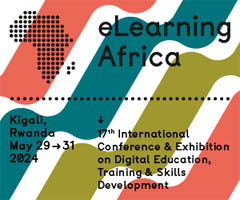Promises for Open Badges and e-Portfolios
 Oulu (FI), December 2015 - Eric Rousselle is CEO at Discendum and has contributed to the development of online learning solutions in both the academic and corporate worlds for over two decades. His topic at OEB will be "Open Badge Passport - Reinventing the ePortfolio with Open Badges" in the session on Friday, 04 December2015 from 16:30 to 17:30.
Oulu (FI), December 2015 - Eric Rousselle is CEO at Discendum and has contributed to the development of online learning solutions in both the academic and corporate worlds for over two decades. His topic at OEB will be "Open Badge Passport - Reinventing the ePortfolio with Open Badges" in the session on Friday, 04 December2015 from 16:30 to 17:30.
What has your experience with Open Badges and e-portfolios been?
Eric Rousselle: It’s logical to start with e-portfolios because they have been around in the academic sector for at least ten years. The Open Badges standard is a newcomer and was created by the Mozilla Foundation in 2011. The standard started to gain popularity about two years ago.
Well, about e-portfolios, my experience is related to the national Kyvyt.fi e-portfolio service (Kyvyt means skills), which my company, Discendum, built in 2008 on the Mahara open-source platform. Today, Kyvyt.fi has more than 40 000 users, who are mainly teachers, tutors, study counselors, and students from secondary and higher-education organisations. Nowadays, Kyvyt.fi is used mainly as a learning portfolio, as a place for collaborative and reflective learning.
It has been both easy and difficult to introduce the concept of modern portfolio (Personal Learning Environment) in Finland. It’s easy because Finnish teachers are well trained in pedagogy and understand the benefit of portfolios in learning. The difficult aspect is because teachers are used to working in teacher-centric and organisation-centric learning-management systems. In particular, at the beginning it was difficult for them to work in a learner-centric environment, which did not allow them to manage their students in the familiar way.
The big challenge for them has been to learn to trust their students and to switch from the traditional role of an instructor to the role of a facilitator. Kyvyt.fi can be seen as a successful concept because every year more schools and universities start using it, but on the other hand we are disappointed in the fact that students make their portfolios because they have to do it and aren’t eager to develop them after they graduate. This problem seems to be related to all academic portfolios. Why? It can be that students don’t see the value of portfolios. Reflecting can sometimes be demanding, and most of the e-portfolio systems are driven by formal education, too complex and not very user friendly.
I’m an active member of the Open Badges movement. Discendum has developed the Open Badge Factory issuing platform and the Open Badge Passport online service. We also issue Open Badges in our training programs and events. My interest in Open Badges is partly related to the need to make better e-portfolios, and I believe that Open Badges can bring more value to them.
If I get an Open Badge issued by a teacher or an employer, I don’t have to write a novel about my skills because a badge is a validated evidence of my skills, competences, achievements, and even attitudes. This means I just have to add my badge in my portfolio. This is an easy way to bring evidence to e-portfolios, and it is appreciated by people who are not interested in spending time on documenting their learning. One other value of Open Badges resides in the fact that badges can capture informal learning, which happens, for example, through work and hobbies.
Bringing evidence of the things we learn in real life could make portfolios more attractive and valuable to their owners and customers. We believe that Open Badges are definitely valuable for e-portfolios, but it’s possible to go further and to reinvent the whole e-portfolio system with Open Badges.
This new approach consists of building a portfolio mainly from badges. Open Badge Passport (openbadgepassport.com) is an example of an Open Badges repository that offers a friendly user interface to set up microportfolio pages easily and community features for collaborative learning. We believe that this approach could shake out the dust of traditional academic portfolios and get different kinds of learners updating their microportfolios in a lifelong learning perspective.
Who recognizes them in Finland or internationally?
Eric Rousselle: E-portfolios have been recognised and widely used internationally for a long time - usually for education, continuing professional development, and employment. Universities in the USA and UK have been especially active in this area. In Finland, e-portfolios as personal learning environments (PLEs) are becoming more and more popular in the education sectors. For example, the City of Helsinki has developed a learning environment for secondary schools built on Mahara, and associations are providing e-portfolios to their members.
Open Badges is a new standard, but thousands of organisations around the world are already issuing badges to their students, members, partners, customers, and employees. In Finland, the standard’s early adopters have been associations, which have been followed by schools, universities, training organisations, and recently corporations. In the education sector, the first Open Badge projects have been related to teachers’ continuing professional development (ICT skills), but badges are now awarded to students to recognise their skills and achievements. In 2015, seventy Finnish organisations have issued about 17,000 badges.
In your opinion, what significance can this educational qualification attain compared to formal certificates?
Eric Rousselle: The problem with certificates issued by the formal education system is that they tell about the course or curriculum completion but rarely about the actual skills and competences of their owners. The value of a formal-education certificate is not in the certificate itself, but in the fact that they are awarded by respected official bodies. Open Badges contain metadata that can be used to tell about its earner’s skills, competences, or achievements.
The value of the badge doesn’t come only from the status of its issuer, but from the value that the badge has for its earner and customers - for example, prospective employers. A badge is much more than a stamp: it is a communication channel. Badges are often compared to certificates and diplomas, but it’s important to understand that badges are much more than the formal education system’s credentials. Badges can capture and recognise informal learning, things we learn anytime and anywhere.
What tools have proven especially easy to manage or practical at the university level or in vocational training?
Eric Rousselle: This is a difficult question, and it’s easier to tell first about solutions that are not as user friendly as they should be. If we speak first about e-portfolios, it’s clear that most of the large portfolio systems on the market should be more flexible, “light”, and user friendly. I think that the Open Badge Passport is an interesting new approach to the e-portfolio concept because it’s easy to manage and could motivate students to work with their portfolios. Open Badge Passport is now an open-source project called SALAVA, and I invite everyone interested in e-portfolios and Open Badges to join its developer community at salava.org.









